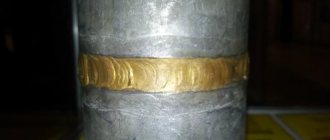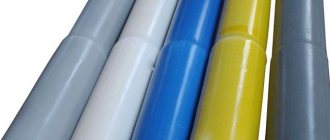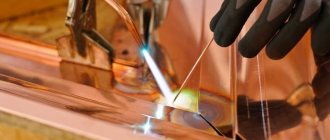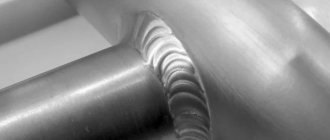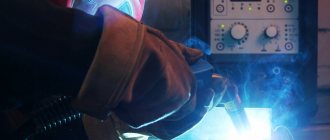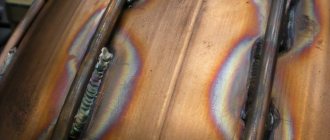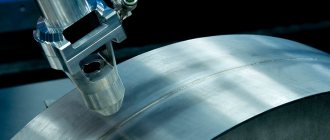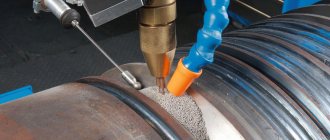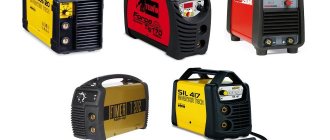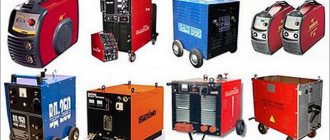Extrusion welding creates strong, permanent plastic-based joints. The procedure is carried out as part of installation and assembly work and provides a solution to many problems:
- production of polyethylene containers for storing liquids;
- laying non-pressure pipelines from HDPE;
- production of plastic cases and composite parts for various devices.
Extrusion welding of polyethylene is advisable when connecting components with a thickness of more than 6 mm. Otherwise, deformation of the products, burns and peeling are likely.
Equipment
To carry out extrusion welding, a special apparatus called an extruder is used. The manual welding device resembles an electric drill with a special nozzle and a heating device, which is why it is called an extrusion gun.
A screw is installed inside the extruder, in which the additive is heated from the extruder body, converted into a viscous homogeneous mass and fed through a shoe to the weld. The additive can be fed into the device either in the form of a wire unwound from a reel, or in the form of granules entering through a hopper.
The shoe is a part of the apparatus that is pressed against the parts being joined and acts as a kind of iron that presses down the filler material and prevents it from spreading in other directions. This device is made of refractory polymers (fluoroplastic, polytetrafluoroethylene), and for each type and size of seam its own shoe is used. The toe of the shoe should follow the shape of the surfaces being joined, but should not touch them.
Hot air is supplied through the shoe (or independently) to heat the joined surfaces. Thus, heating occurs immediately before the additive is supplied. Modern extruders can control air temperature and filler mass temperature.
Depending on the purpose, power and productivity, there are different groups of extruders, slightly different in design. For example, for the production of plastic containers, machines are used in which the air supply nozzle is installed on the right, and welding is carried out strictly from left to right.
Most extruders are produced with a screw, but there are also screwless (plunger) devices. The filler material is pushed out of them due to the pressure of the unmelted rod. The main disadvantage of this type of extruder is low productivity, but it can work in hard-to-reach places.
The price of professional equipment starts from 30 thousand rubles, and the most “advanced” models for industrial welding can cost about one hundred thousand rubles. It should be borne in mind that for extruders from Western companies, wire or granules only from the manufacturer or approved companies are suitable. Domestic devices are less demanding on the quality of additives.
General information
The extrusion method is specially designed to join thick-walled elements. Unlike the traditional one with a rod, where hot air is needed, here with a seam there is almost no pain.
Extrusion is fleeting, the welder’s participation is minimal, you don’t have to worry about observing the process regime, and it takes a long time to master the basics of “seammaking.”
Extrusion science is accessible even to a beginner. Craftsmen will be able to boast of a manual welding extruder by making it themselves.
Welding in manual and automatic modes is up to you. Among the extruders in the first case, Leister fusion 3c stands out. The advantages are a simple and rational body, it weighs modestly, and the performance is higher.
Yes, the rod is also safe in terms of “twisting”. A good range of accessories for welding can be found on the website of the Weldmax online store.
When welding, sometimes you need to walk through narrow places. Leister fusion 2 is suitable for just these purposes. It is easy to use, small in size, and resistant to mechanical stress. Fusion 2 will not upset the engine with cold starts.
It is impossible not to say a few words about the manual screw welding extruder from the line of the same company. None of the entire range of this manufacturer can compare with Leister weldplast s6 in terms of power. However, it is not very noisy, and you will be surprised at how many programs there are.
Theoretical basis
Extrusion welding is applicable only to materials with a wide temperature range at which their viscous-fluid state is maintained, such as polyethylenes, fluorolones, plasticized polyvinyl chloride, polystyrene. Such materials, capable of heating above the pour point, are called thermoplastics. The temperature range between melting and thermal destruction (destruction of the material) for thermoplastics is 50-180°C degrees.
The strength of a joint obtained by extrusion reaches 80-100% of the design strength of the parts themselves, but it strongly depends on the temperature of the additive. The filler material is heated to a temperature exceeding its fluid temperature (Tm) by 30-60°C degrees. The heat of the additive is consumed for losses to the environment, for melting the joined edges of parts and for maintaining the viscous state of the mass itself.
It should be noted that in this case, the heating temperature of the parts should not exceed the temperature of thermal destruction of the material, since this will lead to a decrease in the strength of the connection and will decrease.
The diagram below shows the process of changing the structure of the polymer with increasing temperature.
Only connections made of thermoplastics made of the same material can be connected. In this case, the additive must be made of the same substance as the surfaces being joined. If the parts being welded have different yield strengths, the yield strength of the additive must be equal to the average value of the PT of the parts being joined.
PVC and PVDF have a small range of melting and destruction temperatures, so their connection must be carried out under careful temperature control. To weld such materials, extruders with a screw are required, which thoroughly mixes the viscous mass, and welding must be done in one step, without periodically turning off and heating the extruder.
Extrusion welding can be used to form continuous extended seams on reinforced materials and films. With this connection, the extrusion mass enters the connection of films, which are pulled through rolling rolls. The seam to be joined is then passed through pressure rollers to form a weld seam.
To keep heat loss to a minimum, extrusion welding should be carried out with the largest possible filler rod diameter and high filler feed rate.
Please note that extruder welding is prohibited for use on pressure pipelines.
In Russia, the rules for extrusion welding are regulated by the GOST 16310-80 standard; this standard regulates the types of joints, operating temperature range, part thicknesses, edge sizes and other technical parameters.
In world practice, the use of the German standard DVS 2207-4, which more broadly regulates extrusion welding, is widely used.
Examples of technical welding parameters are given in the table.
Appendix A (mandatory). Extrusion welding protocol
Appendix A (mandatory)
| Extrusion welding of sheets and pipes | Organization | ||||||||||||
| Project | Project number | Weather | Protective measures | ||||||||||
| Drawing N | Material to be welded (manufacturer, type, batch, date): | 1=Sunny | 1=No | ||||||||||
| Welder: | Filler material (manufacturer, type, batch, date): | 2=Dry | 2= Screen/shield | ||||||||||
| N of the attestation certificate/valid until | Welding equipment, manufacturer, type: | 3=Precipitation | 3=Tent | ||||||||||
| Welding Manager | Year of manufacture / Last equipment check: | Welded joint manufacturing method: | 4=Wind | 4=Heating | |||||||||
| date | Welding N | Wall thickness of materials | Weld designation | Welding attachment N | Air consumption, l/min | Melt temperature, °C | Heated gas temperature, °C | Welding speed, cm/min | Ambient temperature, °C | Wall temperature of materials, °C | Weather (Code N) | Protective measures (Code N) | Visual and measuring control |
| Measured at the extruder exit Measured at the center of the preheating nozzle | Notes | ||||||||||||
| Welder's date/signature | Date/signature of welding supervisor |
Types of welds
GOST 16310-80 establishes more than 10 types of welding seams that can be used to connect polymer parts. The name of the seam depends on the appearance of its cut. Let's look at the main ones.
V seam
Using a carpentry tool (hacksaw, chisel or plane), the ends of the materials to be joined are processed. A bevel is created, which at the point of contact should make an angle of 45-90° degrees. At the lower edge of the bevel there should be a straight end no more than 1 mm thick.
If parts of different thicknesses are joined, then the side with the larger thickness is cut at a large angle, and the smaller one at a smaller angle. Thus, equal thickness of the parts at the joint is achieved.
The gap between the parts should not exceed 2 mm to ensure penetration of the additive into the inside of the seam and ensure a high quality connection.
X seam
Unlike a V-shaped seam, in an X seam it is impossible to control the quality of welding. But the double seam is designed to compensate for this shortcoming. For this type of seam, our own manufacturing technology is provided:
Bevels with an opening angle of 30-60° degrees are formed at the connected ends,
The root layer is joined without a gap; preliminary fixation is carried out using a hot air gun. The seam is welded first from the front part, then from the back.
K seam
When using such a seam, the ends are processed with a rounded scraper, then the sheets are pre-fixed using a hot air gun. Additionally, welding can be performed on the second side of the connection.
HV seam
The execution of such a seam is similar to the V-seam, however, the opening angle should not exceed 60° degrees. The parts do not fit together tightly; there is a gap of 2 mm between them. This gap allows the additive to enter the joint and exit from the outside, sealing the joint.
Double HV seam
Extruder welding
1. Principle of extruder welding
1.1 Purpose
Extrusion welding – technological features of the process, equipment design. Extrusion welding is a technology that is used to join materials such as:
- Polypropylene;
- Polyethylene;
- Plastics.
- PVC
- PVDF
Extrusion welding is not used for installation of pressure pipelines. The reason is that the butt arrangement of the elements - pipes - does not provide a strength indicator higher than 80% of the strength of the product itself, in this case pipes made of thermoplastics.
1.2 Requirements
To achieve a high strength of butt welds when welding materials based on PVC and PVDF, 2 basic requirements must be met: 1. Only materials with identical characteristics and chemical composition must be joined. This means the following indicators: • Density; • MFR – melt fluidity indicator. The use of extrusion welding requires the use of filler material corresponding to the density and fluidity of the melt of the joining plastic surfaces. Attention! If the materials being joined have different melt flow rates, it is necessary to select an additive whose MFR is the average fluidity rate. 2. The surfaces to be joined must be thoroughly cleaned. Extrusion welding does not tolerate even small amounts of oxidized material on the surfaces of materials. Therefore, to ensure the strength of joints and seams, cleaning of polypropylene, polyethylene, plastics, and other materials should be carried out 20 minutes before welding. This requirement must be fulfilled as accurately as possible, which is due to the low fluidity and alteration of materials in the area where the seam is formed.
1.3 Extrusion welding - specification
Extrusion welding is focused on joining thick-walled components, parts, surfaces made of PVC, PVDF. Extrusion technology has the following advantages compared to the method of welding materials with hot air using filler material: • Reduces welding time; • Minimizes the influence of the human factor on the strength properties of seams; • Formation of a continuous joint - a seam along the joining surfaces.
1.4 Extrusion welding - technological organization of the process
Extrusion welding technology requires surface preparation before joining. This is done in three ways: • Creating a welding groove, a recess on the joining surfaces; • Formation of a bevel, an angled cut at the ends of the connected surfaces; • Laying materials overlapping. The welding process itself begins with heating the materials in order to bring them to a plastic state. For this purpose, a stream of heated air supplied by the nozzle of a welding extruder is used. Stationary industrial complexes heat materials before welding with radiation. Simultaneously with plasticization, the filler material is prepared. This is done by feeding the base into the extruder screw - PVC granules or rods, which are brought to a viscous-flowing state by heating. Stirring transforms the molten material into a uniform, homogeneous mass. The resulting material is fed with the help of a welding shoe to the place where the surfaces join to form a seam. The welding shoe creates the pressure necessary for this process. Stationary industrial complexes may have a different scheme for the compression effect on the filler material, using separate components and assemblies.
1.5. Features of the welding extruder
Extruders are equipped with air heaters to ensure plasticization of the materials being joined. This is necessary to supply filler material. A stream of hot air enters the welding site through a preheating nozzle, due to which the materials being joined are heated. The temperature of the air flow is regulated by a special controller. There are 2 options for installing an air supply system for heating:
- Built-in air supply units;
- The air supply is organized using external sources. This could be a compressor or a pneumatic network.
In screw-type extruders, the filler material is loaded into a specialized container, a chamber called an extrusion screw.
Its rotation is ensured by an electric motor; its functions are most often performed by a hand drill. The operation of the extruder implies longer operation of the electric screw drive, therefore reliable extruders are equipped with modified drives that have an increased service life. Plasticization of the filler material in the screw is ensured by electric heaters. They are placed on the outside of the auger chamber, their temperature conditions of the heaters are controlled and set through a special control device. Advanced modifications of extruders are equipped with this system. Simple models of devices heat the material in a screw chamber with air passing along the outer contour of the screw chamber. For this purpose, a special cavity is provided in the extruder design. It is then fed into the welding area to plasticize the materials being welded. Such a device for heating the filler material provides for linking the temperature of the air flow passing through the cavity of the screw chamber with the temperature of the air supplied to heat the materials before welding. The additive itself is fed into the welding zone through the welding shoe. Some models are equipped with a simplified system for moving filler material through the heat-affected area. Welding rod - the material enters the profile rollers, they forcefully transfer it into the opening of the heating section, which has a cylindrical shape. This is where electric heaters come into play and begin a thermal effect on the additive, turning it into a homogeneous, heated viscous mass. This scheme turns the rear part of the bar into a pusher for the front. Plunger extruders have low productivity. This feature is compensated by its compact dimensions, which allows you to work with the device in hard-to-reach places. The disadvantage of plunger extruders is the high demands on the diameter and shape of the filler material rod. It should be smooth, without errors. There is no possibility of loading granular material into plunger extruders. The plastic filler mass is supplied to the weld formation site through the welding shoe. This is a common technological feature of screw and plunger welding machines. The working surface of the shoe matches the shape of the mating surfaces. Its front part is equipped with a special nose, which does not allow the entry of filler material in front of the welding zone. The additive exerts pressure on the toe of the shoe, creating a translational movement of the apparatus in a given direction, where a seam is formed. The speed of movement in this case is determined by the performance indicator and the cross-sectional area of the seam. 1.6 Materials to be welded - temperature conditions, features
Most often, HDPE and PP are welded with an extruder. These are thermoplastics of the first group, their advantage is the large temperature range between reaching the state of plasticization and thermal destruction (destruction from exposure to temperatures) is 50–186 degrees C. Significant overheating of such materials does not have a critical effect on them. The second group of thermoplastics includes PVC; PVDF, on the contrary, are distinguished by a small temperature difference between plasticization and thermal destruction. This feature requires increased attention to the temperature regime; it must be observed as accurately as possible. This can only be achieved by debugging the heating system of the device. Welding PVC has one more feature - extruders designed to work with this material are equipped with a specially shaped screw. It ensures thorough mixing of the additive and control of the temperature effect on it. This avoids thermal destruction. The temperature instability of the second group of thermoplastics requires compliance with one more requirement when welding. The device cannot be left in standby mode for a long time; it must be turned off completely during long periods of time. Another disadvantage of PVC is increased chemical activity when heated, as well as abrasiveness. Because of this, specialized technological requirements are imposed on the screw chamber.
2. Shapes of extrusion welds
The basic shapes of extrusion joints are defined in the industry standard DVS 2207-4. The document also contains rules for welding:
- The seams are formed in one pass;
- It is advisable to make a double-sided seam, it provides high strength materials to thermoplastic products;
- Double-sided seam saves filler material.
- A double-sided seam has less impact on the performance of the base sheet or film during cooling.
The GOST 16310-80 standard contains fewer requirements for preparing the basis for welding and its implementation.
There is no description of welding shoes in the regulatory document. At the same time, GOST 16310-80 describes in detail the types and shapes of seams. 3. Shapes and features of welding shoes
The additive, ready for use, enters the seam formation zone through the welding shoe. It also performs the following functions:
- Applies pressure on the incoming material;
- Forms a seam;
- Smoothes the seam surface.
Accordingly, the size and shape of the welding shoe determines the shape and size of the seam.
The material from which the shoe is made is group IV fluoroplastic or PTFE. It has high levels of heat resistance and anti-adhesion. The depth of the pressure creation zone must be at least 1/5 of the seam depth. The depth of the incision should be approximately 0.5 mm, extending forward. This allows the support not to deform the surface of the root layer. This is easy to do, since the material is in a heated state. The shoe nose prevents uncontrolled additive distribution. In turn, the pressure created by it propels the apparatus. The nose of the shoe should not come into contact with the sheets being welded, but its shape should follow their configuration. This requirement can be met by creating a gap between the toe of the shoe and the root layer of 1 to 3 mm. It itself should have a rounded front and back edge. This support prevents additive leakage. To do this, it is necessary to create a clamping force during welding. 4. Preparation for the welding process
Preparation for the welding process Sheets and film must be prepared immediately before starting the process. This is due to the rapid oxidation of the polymer surface. Also, the reason for this requirement is the possibility of contamination on the surface of the substrate: dust, moisture, which will significantly reduce the strength properties of the seam. It is necessary to prepare polymers for welding 20 minutes before the start of welding. If more than the specified time period has passed, you should re-prepare and start welding immediately. Attention! Removal of contamination from the surface of polymers is carried out mechanically, for example, using scrapers. Degreasing compounds are ineffective in preparation for extrusion welding.
4.1 V-stitch
A V-shaped seam requires pre-treatment of the ends and edges of the joining materials. This preparation is carried out using carpentry tools: • Rasp; • Planer; • Hacksaws; • Chisels. The bevel created at the edges should ensure that the seam opens in the range of 45–90 degrees. Thick polymer sheets require creating a bevel with a large angle; thin ones with a smaller one. The opening angle should ensure that the additive fills the entire space formed by the end cuts. The limited opening angle for thick-walled materials is determined by the total width of the seam and overlap zones on its surface. This figure should not exceed 30 mm. Ignoring this requirement will not allow creating the necessary force that will ensure that the additive does not protrude beyond the edges of the welding shoe. The root layer of the seam should contain millimeter-long unmown areas. Their absence will lead to overheating and melting of the material in the welding zone due to uneven movement of the welding machine. The consequence of this will also be a violation of the width of the gap between the sheets; it will become noticeably wider or narrower. The material is fixed before welding begins, thereby creating a uniform gap. Its optimal width should not be more than 2 mm. This will allow the additive to penetrate into the interior of the materials being welded, which guarantees high quality welding. Mechanical processing of the seam should be carried out no closer than 2 mm from the edges of the bevel. This is done provided that the overlap of the joint head in two directions is no more than 2 mm.
4.2 X-stitch
This type of seam is a double-sided version of the V-joint. This allows you to use the same requirements and rules in your work. The only difference is the inability to control the quality of welding of the root layer with an X-shaped seam. This feature changes the requirements for working with the base:
- Bevels are formed at the ends;
- Their opening angle is 30–60 degrees;
- The front side is processed mechanically at a distance of 2 mm from the edge of the bevel;
- The root layer is fixed without gap;
- It is first necessary to carry out the joining using a hot air gun using a special nozzle;
- A V-shaped seam of the front part is formed;
Now you need to turn the sheets over and repeat all the above steps on the other side.
4.3 Joint type HV
For this type of seam, the opening angle is determined by the thickness of the root layer and is 45–60 degrees. The vertical sheet has a more significant influence on this. Here it is necessary to leave a non-beveled area 1 mm wide at the end. The sheets must be fixed so that there is a gap of 2 mm between them. This will guarantee high-quality welding. Attention! The distance from the edge of the horizontal sheet to the beginning of the seam after welding must be at least 10 mm. The plane located on the left side is processed mechanically no closer than 3 mm from the edge of the bevel. Here it is necessary to provide a reserve. The algorithm of actions when forming a seam of the HV shape is similar to creating an X-shaped seam.
4.4 K-stitch
Corner internal connection requires preliminary fixation of sheets. This is done using a hot air gun. For temporary welding, a special nozzle or nozzle with filler material is suitable. The temporary fixation area is processed using a scraper:
- When using a welding attachment, this is done with the sharpened edge of a scraper;
- The use of filler material requires machining with a rounded scraper surface.
The root layer is now ready for extrusion welding. Seam with variable cross-section The seam configurations presented above are idealized, but often the operator is faced with the need to form a seam whose cross-section will change. An example of such work is welding a pipe into a pipe of a larger diameter. For the high-quality implementation of such a task, modernization of the shoe is required. This is a parallelepiped with rounded corners; it is in contact with the upper part of the root base, where the angle between the straight sheets is 90 degrees, and with the lower part, where the angle can reach 120–140 degrees.
The process of connecting parts
The process of preparing and carrying out welding work using extrusion coatings is as follows:
- After starting and warming up the extruder, it is cleaned of previously used material. The additive cannot be reused because its strength characteristics are reduced,
- 15-20 minutes before the start of welding work, the surfaces to be joined are cleaned of dust, oil and grease contamination by mechanical action (scrapers, fine sandpaper),
- The ends of the joints are processed for the required seam, bevels or welding grooves are prepared on the surfaces to be joined,
- The surfaces to be joined are heated with hot air,
- The additive material enters the extruder, where it is heated from the jacket of the screw chamber and mixed until a homogeneous paste-like mass is obtained,
- The extrusion, heated to a viscous state, is squeezed through the shoe onto the welding seam, partially melting the parts being welded and mixing with their substance,
- The necessary pressure is applied to the surfaces to be welded using a welding shoe to ensure the fixation of the parts. The strength of the applied pressure depends on the materials: for example, for LDPE a wide range of pressures is acceptable, and the strength of the polypropylene connection decreases when too high pressure is applied.
- The cooling process takes place under natural conditions, since forced cooling leads to a decrease in the strength of the seam due to temperature changes.
There are two main types of extrusion welding – non-contact and contact.
The non-contact welding method requires the use of clamping devices or presses, which apply pressure to the parts being joined. With this method, extrusion is supplied from a mouthpiece that is not inserted into the connector.
With the contact method, the mouthpiece is inserted into the connector to be connected until it contacts the edges and moves along the joint at an angle of 10-15° degrees, filling the cavity with filler mass. The pressure created by the additive eliminates the need to apply additional pressure to the material. Such welding allows for heat loss and additional heating of the joined surfaces due to the heat from the mouthpiece.
Welding plastic using solvents
There is another type of welding for polymers, using solvents. To do this, a specialist will need to perform a certain series of actions: wetting the welded edges in a solvent, waiting for the material to swell under chemical action and become soft, using pressure to adhere and harden the weld. This type of welding is used in conjunction with amorphous polymers, which are well suited for this task. Materials that have a crystalline structure usually also have high resistance to solvents.
To wet two surfaces, as a rule, a regular sponge or other similar material is used. The amount of solvent should not be large so as not to cause leaks that are destructive to the material. Immediately after wetting and softening, both surfaces must be immediately attached to each other. Sometimes additional heat is also used to speed up the evaporation of the solvent. In general, solvent welding of plastics is simple and cheap, but due to the toxic fumes from the solvents themselves, it is rarely used, in fact, only in cases where other methods do not work.
